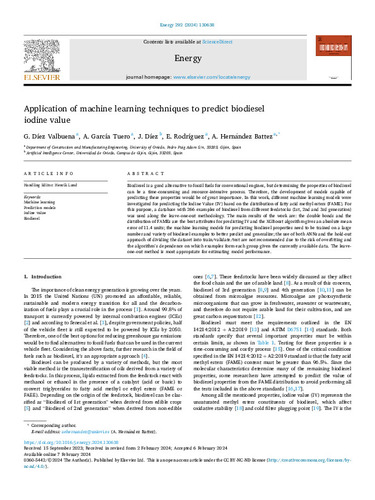Application of machine learning techniques to predict biodiesel iodine value
Fecha de publicación:
Versión del editor:
Citación:
Resumen:
Biodiesel is a good alternative to fossil fuels for conventional engines, but determining the properties of biodiesel can be a time-consuming and resource-intensive process. Therefore, the development of models capable of predicting these properties would be of great importance. In this work, different machine learning models were investigated for predicting the Iodine Value (IV) based on the distribution of fatty acid methyl esters (FAME). For this purpose, a database with 266 examples of biodiesel from different feedstocks (1st, 2nd and 3rd generation) was used along the leave-one-out methodology. The main results of the work are: the double bonds and the distribution of FAMEs are the best attributes for predicting IV and the XGBoost algorithm gives an absolute mean error of 11.4 units; the machine learning models for predicting biodiesel properties need to be trained on a large number and variety of biodiesel examples to better predict and generalize; the use of both ANNs and the hold-out approach of dividing the dataset into train/validate/test are not recommended due to the risk of overfitting and the algorithm's dependence on which examples form each group given the currently available data. The leave-one-out method is most appropriate for estimating model performance.
Biodiesel is a good alternative to fossil fuels for conventional engines, but determining the properties of biodiesel can be a time-consuming and resource-intensive process. Therefore, the development of models capable of predicting these properties would be of great importance. In this work, different machine learning models were investigated for predicting the Iodine Value (IV) based on the distribution of fatty acid methyl esters (FAME). For this purpose, a database with 266 examples of biodiesel from different feedstocks (1st, 2nd and 3rd generation) was used along the leave-one-out methodology. The main results of the work are: the double bonds and the distribution of FAMEs are the best attributes for predicting IV and the XGBoost algorithm gives an absolute mean error of 11.4 units; the machine learning models for predicting biodiesel properties need to be trained on a large number and variety of biodiesel examples to better predict and generalize; the use of both ANNs and the hold-out approach of dividing the dataset into train/validate/test are not recommended due to the risk of overfitting and the algorithm's dependence on which examples form each group given the currently available data. The leave-one-out method is most appropriate for estimating model performance.
ISSN:
Notas Locales:
OA ATUO24
Patrocinado por:
This research was funded by the Ministry of Science, Innovation and Universities (Spain) and the State Investigation Agency, grant number: PID2022-136656NB-100 (LubeMicroAlgae project), and by the Foundation for the Promotion of Applied Scientific Research and Technology in Asturias (Spain), which financed the contract of Guillermo Díez at the University of Oviedo (Spain), grant number: SV-PA-21-AYUD/2021/50987. Guillermo Díez-Valbuena acknowledges the support of the Goverment of the Principality of Asturias under Severo Ochoa predoctoral program (ref. BP22-153).
Colecciones
- Artículos [37543]
- Construcción e Ingeniería de Fabricación [504]
- Investigaciones y Documentos OpenAIRE [8370]
Ficheros en el ítem





